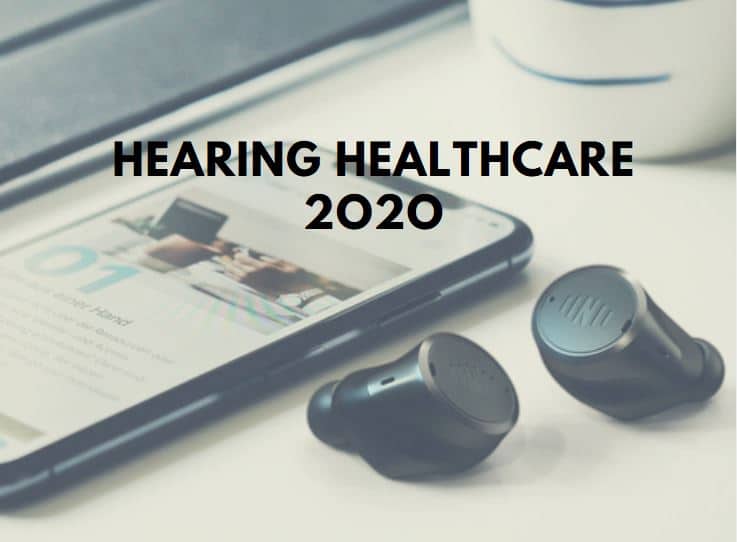Hearing Healthcare 2020 is a regular column where we explore the forces behind the changing landscape and disruptions impacting the hearing healthcare industry.
This week, HHTM President and CEO, Kevin Liebe, connected with David Cannington, co-founder and Executive Director of Nuheara, to discuss the future of the hearable industry and how Nuheara has managed to find success where many other companies have failed.
KL: To start, could you provide readers with some of your background and how you came to be interested in the hearable space? What brought you to Nuheara?
DC: We’ve been thinking about hearables for over a decade now. Justin Miller and I built a previous hearing tech company, called Sensear, in the industrial space where we sold smart hearables. In that case, Sensear made wired over-the-ear headsets and wired earbuds. The tech was able to separate speech from noise in loud industrial environments where workers had to wear hearing protection, allow them to remain situationally aware, and connect to Bluetooth devices and two way radios. They were really the one of the first hearables on the market.
This was where the light went off about Nuheara. We met thousands of workers around the world who loved the concept of hearing speech in noisy environments, but wanted a smaller device.
Justin and I believed that one day we would be able to embed smart hearing tech in a small truly wireless earbud that connects to a Bluetooth device and would have the ability to help people hear better and improve the quality of their lives. Two years after leaving that company, we founded Nuheara to bring this dream to reality.
KL: Since the term ‘hearable’ was first coined in 2014 by Nick Hunn, we have seen several promising startups leave the space altogether. Why is this such a difficult industry for a startup and what do you attribute Nuheara’s success to so far?
DC: The concept of hearables as a technology platform has been at the forefront of our minds for over a decade. Since Justin and I and our team have been building these types of products for a long time now, it has given us a real competitive advantage. Nothing can replace domain expertise, and our team has this in droves.
We knew it was more difficult than most of the start-ups would have imagined. We watched them make mistakes. One of the biggest in our minds was making product functionality promises we knew would be difficult to achieve. We also saw other companies spend too much, too early on marketing when the market wasn’t ready to scale.
The fact is, hearables are hard. We know from first-hand experience. But we have made the right decisions around how we have grown the business and built the brand. We knew the market wouldn’t be built overnight, we have been efficient with a capital utilization, and been super focused on our customers.
Regarding capital utilization, even though Perth is one of the most isolated cities in the world, it is an extremely cost efficient place to build a tech business like Nuheara. We have attracted world-class engineering talent who are extremely loyal to our mission. To build the same team in Silicon Valley, it would have been a way more expensive proposition. On top of that, the Australian Government has a research and development rebate system that allows Nuheara to receive 42 cents back for every $1 we spend in R&D. So after 4 years in building the business we have spent significantly less than our fellow competitors, some who are no longer around, had in half that time.
From a consumer focus perspective, IQbuds BOOST was developed because customers wanted personalized hearing, IQstream TV was developed because TV listening is a major problem for people with hearing challenges, and IQbuds2 MAX brings Active Noise Cancellation to the consumer because they demand great sound fidelity with all the hearing benefits. Every evolution of the product has been about solving customers’ problems with cutting edge hearable tech. But the real secret for Nuheara’s success has been the dedicated and talented team we have built both here in Perth and around the globe.
KL: We’ve seen several large tech companies become involved in the hearable space, most recently Amazon, with its Echo Buds. Does this discourage startups from entering the space?
DC: We have known that Amazon was building a hearable. We met with them over 2 ½ years ago after we first launched IQbuds. Six months after they brought the first-generation Echo buds to market, we will start shipping our 3rd generation product IQbuds2 MAX. All the big tech companies are dabbling in hearables, but they are all finding it’s a challenge.
The fact that we are small means we can innovate super quickly. It took us 12 months from a working wearable prototype on IQbuds to bring that product in market. IQbuds2 MAX had a similar development cycle. In that case, we had 2 previous generations to learn from.
Nuheara has always taken this approach: “if we focus on delivering a product that fundamentally changes people’s lives, this will drive us to success.” There is room for many players in this rapidly growing market. As one example, Apple has been in the headset market since they brought out their white wired earbuds many years ago. There are some very big audio companies that have grown and prospered during this period.
We are grateful to the big guys, as they have helped the hearables segment cross the chasm. This will benefit all of us. We are seeing this in our sales results since more competition came to market. Competition is healthy.
KL: Due to the high demand, some analysts are predicting that AirPods could soon become Apple’s third largest business by 2021. In your opinion, how has the popularity of AirPods impacted the industry?
DC: I think I answered this above. To reiterate, Airpods have made it socially acceptable to wear something quite weird looking in your ears, so long as it doesn’t look like a hearing aid. Its notable that Phonak and Starkey have launched new products in January 2020. Both of these are hearing aids that have taken a form factor that looks more like IQbuds than a traditional hearing aid.
This is acknowledgment that hearables are having an impact on how the big players, including the big 5 hearing aid companies, are seeing the ever-changing consumer landscape.
We think this is great news. When you look at how the functionality of IQbuds2 MAX at US$399 compares to these hearable looking hearing aids whose price exceeds $5K, consumers will start thinking hard about how much they want to spend on their hearing health. At CES earlier this month, we had a few friendly journalists wearing the Phonak Virto product at our booth who conducted a side by side comparison with IQbuds2 MAX. Of course the Phonak product was personalized to the journalist, and IQbuds2 MAX was not. However, the journalists said the hearing processing with the Virto was better (no surprise!) but the sound fidelity on the IQbuds2 MAX was better.
The lines are becoming more and more blurred between consumer hearables and hearing aids.
KL: Few people realize that Nuheara has already integrated the widely used NAL-NL2 hearing aid fitting algorithm formula into its hearing devices. What was the motivation behind this and do you believe this will be a competitive advantage when OTC regulations are finalized in the US?
DC: In 2017, our team realized that if we were going to deliver a powerful hearing experience for consumers, it required personalization. We turned to National Acoustic Labs to embed NAL-NL2 into IQbuds BOOST. This has turned out to be a pivotal decision for Nuheara. It gives the consumer a clinical validated method to self-assess and auto-calibrate their IQbuds BOOST and now IQbuds2 MAX from the comfort of their own home.
Ear ID, Nuheara’s Hearing Personalization system, has been incredibly successful. Consumers love the convenience and personalized enhancement with Ear ID. It has also allowed Nuheara to understand our consumers and where they fit in their hearing health journey. As expected, we are servicing a younger consumer with an average age of 55. Many of these are at the beginning of their hearing health journey and fit into the mild-to-moderate hearing loss category. This has been incredibly reassuring for Nuheara. It fits with our strategy of making hearing health affordable and accessible.
The good news is that our partnership with NAL continues to evolve, and we are proud to work with them, given their reputation in the hearing industry.
KL: Thanks for taking the time to share your views with us today, David.
DC: Thanks Kevin. It’s a pleasure to be in your network and thanks for acknowledging that hearables are an important link to the hearing health eco-system.
 David Cannington is the Co-founder, Executive Director and Chief Marketing Officer of Nuheara, an ASX listed innovative smart hearing company. David’s international career spans senior marketing and advertising roles in Fortune 1000 companies. He has spent the last 27 years in San Francisco founding, advising and operating early stage technology startups with global aspirations in both the B2C and B2B space. For the last 12 years he has been focused on growing globally two Australia hearing technology companies. David is passionate about building businesses that have a real impact on people’s lives.
David Cannington is the Co-founder, Executive Director and Chief Marketing Officer of Nuheara, an ASX listed innovative smart hearing company. David’s international career spans senior marketing and advertising roles in Fortune 1000 companies. He has spent the last 27 years in San Francisco founding, advising and operating early stage technology startups with global aspirations in both the B2C and B2B space. For the last 12 years he has been focused on growing globally two Australia hearing technology companies. David is passionate about building businesses that have a real impact on people’s lives.
 Kevin Liebe, AuD, is President and CEO of Hearing Health & Technology Matters (HHTM). He also serves as a Scientific Advisor to Neosensory, a Silicon Valley based startup pioneering experiences in sensory augmentation. As an audiologist, Kevin has experience in variety of settings, including private practice, ENT, and industry. He is a past president and board member of the Washington State Academy of Audiology
Kevin Liebe, AuD, is President and CEO of Hearing Health & Technology Matters (HHTM). He also serves as a Scientific Advisor to Neosensory, a Silicon Valley based startup pioneering experiences in sensory augmentation. As an audiologist, Kevin has experience in variety of settings, including private practice, ENT, and industry. He is a past president and board member of the Washington State Academy of Audiology







